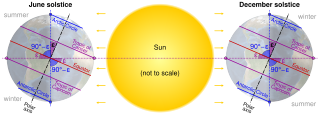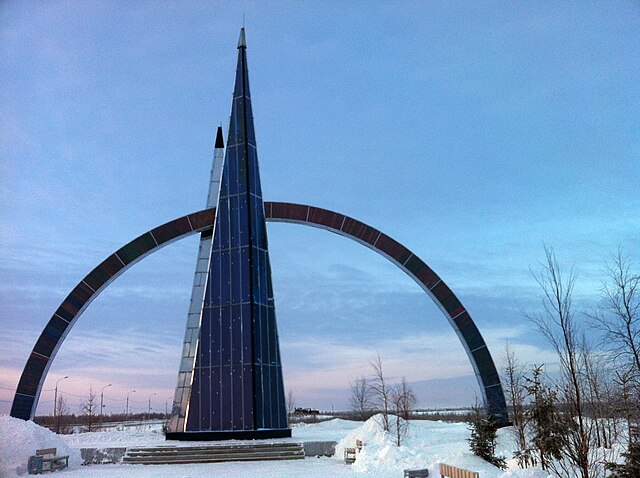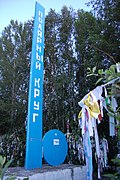Top Qs
Timeline
Chat
Perspective
Arctic Circle
Boundary of the Arctic From Wikipedia, the free encyclopedia
Remove ads
The Arctic Circle is one of the two polar circles, and the northernmost of the five major circles of latitude as shown on maps of Earth at about 66° 34' N.[1] Its southern counterpart is the Antarctic Circle.

The Arctic Circle marks the southernmost latitude at which, on the winter solstice in the Northern Hemisphere, the Sun does not rise all day, and on the Northern Hemisphere's summer solstice, the Sun does not set. These phenomena are referred to as polar night and midnight sun respectively, and the further north one progresses, the more obvious this becomes. For example, in the Russian port city of Murmansk, three degrees north of the Arctic Circle, the Sun stays below the horizon for 20 days before and after the winter solstice, and above the horizon for 20 days before and after the summer solstice.[2][3][4]
The position of the Arctic Circle is not fixed and currently runs 66°33′50.6″ north of the Equator.[5] Its latitude depends on Earth's axial tilt, which fluctuates by a margin of some 2° over a 41,000-year period, due to tidal forces resulting from the orbit of the Moon.[6] Consequently, the Arctic Circle is currently drifting northwards at a speed of about 14.5 m (48 ft) per year.
Remove ads
Etymology
The word arctic comes from the Greek word ἀρκτικός (arktikos: "near the Bear, northern")[7] and that from the word ἄρκτος (arktos: "bear").[8]
Midnight sun and polar night
Summarize
Perspective

The Arctic Circle is the southernmost latitude in the Northern Hemisphere at which the centre of the Sun can remain continuously above or below the horizon for twenty-four hours; as a result, at least once each year at any location within the Arctic Circle the centre of the Sun is visible at local midnight, and at least once the centre is not visible at local noon.[9]
Directly on the Arctic Circle these events occur, in principle, exactly once per year: at the June and December solstices, respectively. However, because of atmospheric refraction and mirages, and also because the sun appears as a disk and not a point, part of the midnight sun is visible, on the night of the northern summer solstice, at a latitude of about 50 minutes of arc (′) (90 km (56 mi)) south of the Arctic Circle. Similarly, on the day of the northern winter solstice, part of the Sun may be seen up to about 50′ north of the Arctic Circle. That is true at sea level; those limits increase with elevation above sea level, although in mountainous regions there is often no direct view of the true horizon.
Remove ads
Human habitation

The largest communities north of the Arctic Circle are situated in Russia, Norway, and Sweden: Murmansk (population 295,374) and Norilsk (178,018) in Russia; Tromsø (75,638) in Norway, Vorkuta (58,133) in Russia, Bodø (52,357) and Harstad (24,703) in Norway; and Kiruna, Sweden (22,841). In Finland, the largest settlement in the immediate vicinity of the Arctic Circle is Rovaniemi (62,667), lying 6 km (4 mi) south of the line. Salekhard (51,186) in Russia is the only city in the world located directly on the Arctic Circle.[10]
In contrast, the largest North American community north of the Arctic Circle, Sisimiut (Greenland), has approximately 5,600 inhabitants. In the United States, Utqiagvik, Alaska (formerly known as Barrow) is the largest settlement north of the Arctic Circle with about 5,000 inhabitants. The largest such community in Canada is Inuvik in the Northwest Territories, with 3,137 inhabitants.
Geography
Summarize
Perspective
The Arctic Circle is roughly 16,000 km (9,900 mi) in circumference.[11] The area north of the Circle is about 20,000,000 km2 (7,700,000 sq mi) and covers roughly 4% of Earth's surface.[12]
The Arctic Circle passes through the Arctic Ocean, the Scandinavian Peninsula, North Asia, Northern America, and Greenland. The land within the Arctic Circle is divided among eight countries: Norway, Sweden, Finland, Russia, the United States (Alaska), Canada (Yukon, Northwest Territories, and Nunavut), Denmark (Greenland), and Iceland (where it passes through the small offshore island of Grímsey).
Climate
The climate north of the Arctic Circle is generally cold, but the coastal areas of Norway have a generally mild climate as a result of the Gulf Stream, which makes the ports of northern Norway and northwest Russia ice-free all year long. In the interior, summers can be quite warm, while winters are extremely cold. For example, summer temperatures in Norilsk, Russia will sometimes reach as high as 30 °C (86 °F), while the winter temperatures frequently fall below −50 °C (−58 °F).
Sites along the Arctic Circle





Starting at the prime meridian and heading eastwards, the Arctic Circle passes through:
Remove ads
Gallery
- Arctic Circle marker on island of Grímsey in Iceland
- Northern Polar Circle Globe on Vikingen island marking the Arctic Circle in Norway
- Arctic Circle sign by the Inland Line railway, Sweden
- Polcirkeln portal near Nattavaara, Sweden
- The white borderline of the Arctic Circle at the Santa Claus Village in Rovaniemi, Finland
- Arctic Circle line 66° 32′ 35″ in Santa Claus Village, Finland
- Arctic Circle sign in the Republic of Karelia, Russia
- Arctic Circle sign in the Tazovsky District, Russia
- A sign near Zhigansk (Yakutia), Russia
- A sign along the Dalton Highway marking the location of the Arctic Circle in Alaska, United States
Remove ads
See also
References
External links
Wikiwand - on
Seamless Wikipedia browsing. On steroids.
Remove ads










